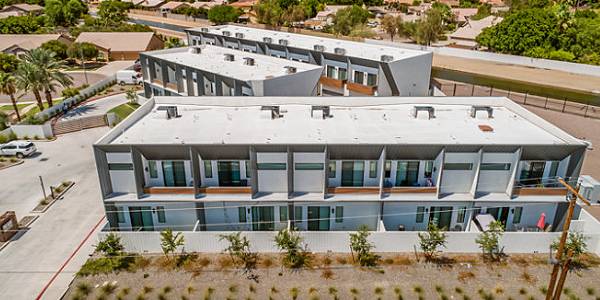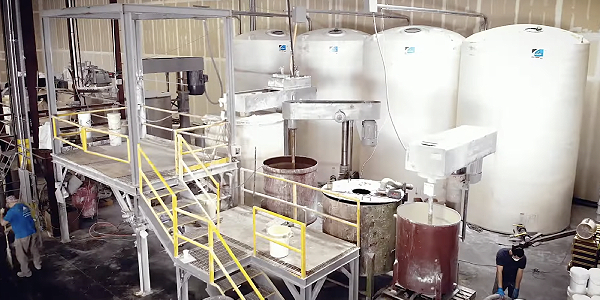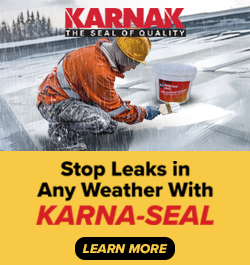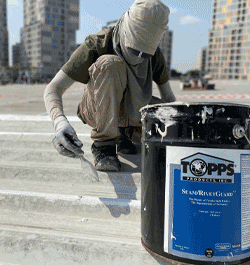UP TO THE MINUTE
How roof coatings improve a roof’s overall performance

By KARNAK Coatings
Learn from the experts at KARNAK about the differences between painting and coating a roof and why coated roofs are worth the investment.
When looking for ways to improve the longevity of a roof system, there is a distinct shift in the industry towards coatings as a solution. These coatings can be added to an existing roof and significantly increase that roof’s lifespan. Roof coatings offer many other benefits, such as ease of installation and affordability. In this article, the experts at KARNAK share the differences in painting and coatings roofs.
Paint versus roof coating
For most of us, it is understandable that the application of a liquid using a brush, roller or spray would be referred to as “painting.” After all, at one point or another we have painted or had someone paint the walls and trim of our house. So, when we see someone applying a fluid product to a roof, our reaction is that roof is being “painted.” But, if a roof coating is being used and applied properly, the roof is being “coated.”
[Insert ProperlyLayeredCoatings.png to the left of “What’s the big deal” h3]
What’s the big deal?
For starters “paint” and “roof coating” are not the same, and they are each designed for different purposes. Paints typically have lower solids content than coatings, are generally thinner in viscosity and are usually applied to rigid surfaces.
On the other hand, roof coatings contain high performance binders and have higher solids content. They are specifically formulated to perform and protect low-slope residential, commercial and industrial roofs from the damaging effects of weather and harsh environmental conditions such as UV light, water exposure and wind. Roof coatings are fully exposed and directly facing the elements 24 hours a day, 365 days a year. They are typically applied to elastic, dynamic substrates such as modified asphalt, thermoplastic/thermo-set membranes and metal, which are characterized by high elongation and contraction properties, all of which can experience hundreds of thermal cycles per day.
A coating’s robust formulation contains high quality elastomeric resins and additives designed to adhere to these substrates to provide many years of protection and service. These resins and modifiers allow coatings to expand and contract with the roof, providing a continuous, durable protective film.
The term “painting a roof” recalls the image of someone rolling on sufficient “paint” to change the color of the roof surface. However, if the product being applied is actually paint, it will probably fail (even when applied at the correct paint manufacturer’s recommended coverage). Paint is usually acceptable for application to a bedroom wall or exterior siding, but “coating a roof” on the other hand requires application of a “roof coating” (by roller, brush or airless sprayer) at a specified coverage rate and in a continuous film. In the image on the left, there is an example of how a coating should be applied.
Application
Besides surface preparation, following the recommended coverage rate is critical when applying a roof coating. A roof coating not applied in the proper sequence, number of coats and recommended coverage rate will not develop the required finish film properties. Failure to apply properly may lead to poor adhesion, possible delamination and premature failure. A coating application requires deliberate thoughtful preparation and application.
The use of roof coating begins with the understanding that a building owner already has a viable roof, which of course should be verified first by conducting a visual inspection and moisture survey. Why replace the entire roof when you can repair the problem areas and then apply a roof coating system over top? Typically roof coatings are used in conjunction with compatible roof cements for sealing and repairs, leading them to be called “roof coating systems” that may also employ using two or more coats and may include the use of fabric reinforcement depending on the conditions (flashing, penetrations, etc.) of the existing roof. Roof coating systems may include primers, substrate-specific base coats and reflective finish coats.
Why roof coating systems are enjoying dramatic growth
The benefits of roof coating systems check several important boxes. To the roofing contractor, they offer another stream of revenue that helps their building owner's clients maximize the service lives of their roofs. This can help contractors maintain contact with clients and better position them to install the next roof when the time comes. Roof coating systems are installed with smaller crews than what is needed for reroofing, making them attractive options in today’s reduced labor market.
Building owners stand to gain the most from roof coating systems. From an economic standpoint, they can avoid or delay the removal of an existing roof and avoid the associated disposal costs, which are getting higher as landfill space reaches a premium. They also avoid the possibility of having to bring the roof up to current energy code requirements if a new roof is installed. Associated savings for building owners can be realized as well as the potential to reduce a building’s peak cooling demand with the use of highly reflective finish roof coatings.
Other benefits
Not all the benefits of roof coating systems are directly linked to monetary savings. The application of coating systems avoids disrupting the inside work environment, making them more attractive to building owners who cannot afford to temporarily shut down or move operations while reroofing is taking place. Roof coating systems are sustainable. When the coating system draws near the end of its useful life, the roof can be recoated to extend the life of the original coating system.
An investment in a roof coating system is one of the most affordable, long-term solutions to extend the service life and increase the return on investment of many roofs.
Selecting a manufacturer with long-term experience and reputation in the manufacture of roof coatings is your best starting place.
Original article source: KARNAK
Learn more about KARNAK Reflective Coatings, Sealants and Cements in their Coffee Shop Directory or visit www.karnakcorp.com.
Recommended For You

What makes cool roofs so cool?
Read More ...
Innovating with the contractor in mind
Read More ...
Everest Systems introduces new polyurea system
Read More ...














Comments
Leave a Reply
Have an account? Login to leave a comment!
Sign In